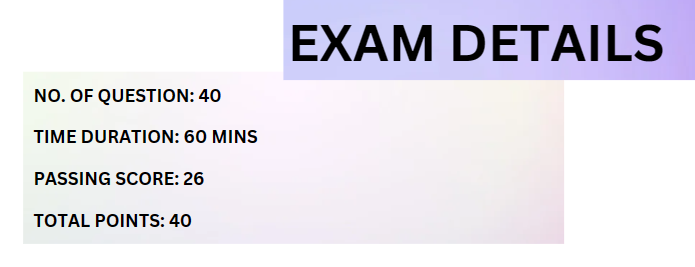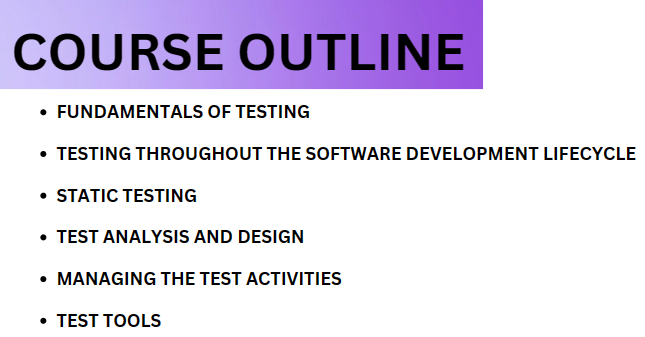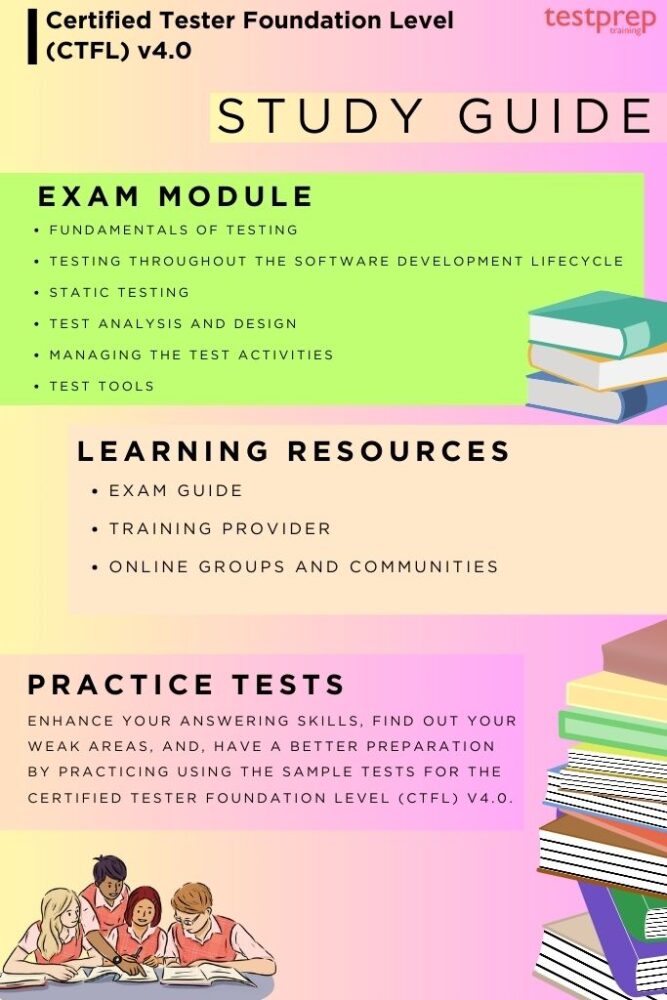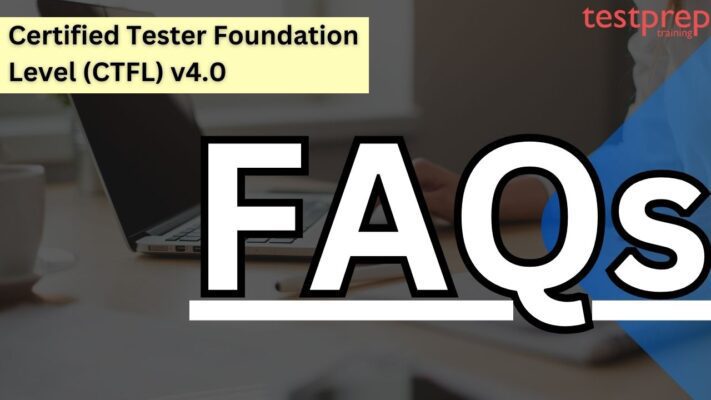Certified Tester Foundation Level (CTFL) v4.0 [NEW!]
![Certified Tester Foundation Level (CTFL) v4.0 [NEW!]](https://www.testpreptraining.com/tutorial/wp-content/uploads/2023/11/Certified-Tester-Foundation-Level-CTFL-v4.0-711x400.jpg)
The ISTQB® Certified Tester Foundation Level (CTFL) certification is the key to fundamental testing knowledge you can use in real-world situations. The course covers important terms and ideas in the testing field globally, making it useful for different software delivery methods like Waterfall, Agile, DevOps, and Continuous Delivery. Having the CTFL certification is a must before pursuing other ISTQB® certifications that demand a Foundation Level qualification.
Target Audience:
The CTFL 4.0 certification is perfect for anyone wanting to show practical knowledge about the essential concepts of software testing. It’s great for roles like testers, test analysts, test engineers, consultants, managers, user acceptance testers, and software developers. Not only that, but it’s also useful for those who just need a basic understanding of software testing, like project managers, quality managers, software development managers, business analysts, IT directors, and management consultants.
Through the ISTQB® Certified Tester Scheme, testing professionals can tap into a wealth of knowledge at any point in their careers. Plus, there’s the chance to go for higher-level software testing qualifications like the Core Advanced Levels, Specialist, and Expert Level certifications. It’s a pathway for continuous learning and growth in the field.
What you will learn?
When someone achieves the new Foundation Level certification, there are specific business outcomes expected:
- Grasp the purpose and benefits of testing.
- Comprehend the basic ideas behind software testing.
- Recognize the suitable test approach and activities based on the testing context.
- Evaluate and enhance the quality of documentation.
- Boost the efficiency and effectiveness of testing.
- Harmonize the test process with the software development lifecycle.
- Understand the principles of test management.
- Write and communicate clear and understandable defect reports.
- Understand the factors influencing priorities and efforts in testing.
- Collaborate effectively within a cross-functional team.
- Recognize risks and advantages associated with test automation.
- Identify crucial skills needed for testing.
- Grasp the impact of risk on testing.
- Report on test progress and quality effectively.
Exam Details

- The exam comprises 40 questions, each carrying one point, for a total of 40 points.
- To pass, you need to score at least 26 points.
- The exam duration is 60 minutes, with an additional 25% of the time provided for non-native language speakers.
Course Outline
The content you’ll be tested on is divided into six chapters, and each chapter has a specified training time mentioned at the top level. However, the specific timing details are not given below the chapter level. Accredited training courses must cover a minimum of 1135 minutes (equivalent to 18 hours and 55 minutes) of instruction, spread across these six chapters according to the syllabus.

Fundamentals of Testing – 180 minutes
1.1 What is Testing?
FL-1.1.1 (K1) Identify typical test objectives
FL-1.1.2 (K2) Differentiate testing from debugging
1.2 Why is Testing Necessary?
FL-1.2.1 (K2) Exemplify why testing is necessary
FL-1.2.2 (K1) Recall the relation between testing and quality assurance
FL-1.2.3 (K2) Distinguish between root cause, error, defect, and failure
1.3 Testing Principles
FL-1.3.1 (K2) Explain the seven testing principles
1.4 Test Activities, Testware and Test Roles
FL-1.4.1 (K2) Summarize the different test activities and tasks
FL-1.4.2 (K2) Explain the impact of context on the test process
FL-1.4.3 (K2) Differentiate the testware that supports the test activities
FL-1.4.4 (K2) Explain the value of maintaining traceability
FL-1.4.5 (K2) Compare the different roles in testing
1.5 Essential Skills and Good Practices in Testing
FL-1.5.1 (K2) Give examples of the generic skills required for testing
FL-1.5.2 (K1) Recall the advantages of the whole team approach
FL-1.5.3 (K2) Distinguish the benefits and drawbacks of independence of testing
Testing Throughout the Software Development Lifecycle – 130 minutes
2.1 Testing in the Context of a Software Development Lifecycle
FL-2.1.1 (K2) Explain the impact of the chosen software development lifecycle on testing
FL-2.1.2 (K1) Recall good testing practices that apply to all software development lifecycles
FL-2.1.3 (K1) Recall the examples of test-first approaches to development
FL-2.1.4 (K2) Summarize how DevOps might have an impact on testing
FL-2.1.5 (K2) Explain the shift-left approach
FL-2.1.6 (K2) Explain how retrospectives can be used as a mechanism for process improvement
2.2 Test Levels and Test Types
FL-2.2.1 (K2) Distinguish the different test levels
FL-2.2.2 (K2) Distinguish the different test types
FL-2.2.3 (K2) Distinguish confirmation testing from regression testing
2.3 Maintenance Testing
FL-2.3.1 (K2) Summarize maintenance testing and its triggers
Static Testing – 80 minutes
3.1 Static Testing Basics
FL-3.1.1 (K1) Recognize types of products that can be examined by the different static test techniques
FL-3.1.2 (K2) Explain the value of static testing
FL-3.1.3 (K2) Compare and contrast static and dynamic testing
3.2 Feedback and Review Process
FL-3.2.1 (K1) Identify the benefits of early and frequent stakeholder feedback
FL-3.2.2 (K2) Summarize the activities of the review process
FL-3.2.3 (K1) Recall which responsibilities are assigned to the principal roles when performing reviews
FL-3.2.4 (K2) Compare and contrast the different review types
FL-3.2.5 (K1) Recall the factors that contribute to a successful review
Test Analysis and Design – 390 minutes
4.1 Test Techniques Overview
FL-4.1.1 (K2) Distinguish black-box, white-box and experience-based test techniques
4.2 Black-box Test Techniques
FL-4.2.1 (K3) Use equivalence partitioning to derive test cases
FL-4.2.2 (K3) Use boundary value analysis to derive test cases
FL-4.2.3 (K3) Use decision table testing to derive test cases
FL-4.2.4 (K3) Use state transition testing to derive test cases
4.3 White-box Test Techniques
FL-4.3.1 (K2) Explain statement testing
FL-4.3.2 (K2) Explain branch testing
FL-4.3.3 (K2) Explain the value of white-box testing
4.4 Experience-based Test Techniques
FL-4.4.1 (K2) Explain error guessing
FL-4.4.2 (K2) Explain exploratory testing
FL-4.4.3 (K2) Explain checklist-based testing
4.5. Collaboration-based Test Approaches
FL-4.5.1 (K2) Explain how to write user stories in collaboration with developers and business representatives
FL-4.5.2 (K2) Classify the different options for writing acceptance criteria
FL-4.5.3 (K3) Use acceptance test-driven development (ATDD) to derive test cases
Managing the Test Activities – 335 minutes
5.1 Test Planning
FL-5.1.1 (K2) Exemplify the purpose and content of a test plan
FL-5.1.2 (K1) Recognize how a tester adds value to iteration and release planning
FL-5.1.3 (K2) Compare and contrast entry criteria and exit criteria
FL-5.1.4 (K3) Use estimation techniques to calculate the required test effort
FL-5.1.5 (K3) Apply test case prioritization
FL-5.1.6 (K1) Recall the concepts of the test pyramid
FL-5.1.7 (K2) Summarize the testing quadrants and their relationships with test levels and test types
5.2 Risk Management
FL-5.2.1 (K1) Identify risk level by using risk likelihood and risk impact
FL-5.2.2 (K2) Distinguish between project risks and product risks
FL-5.2.3 (K2) Explain how product risk analysis may influence thoroughness and scope of testing
FL-5.2.4 (K2) Explain what measures can be taken in response to analyzed product risks
5.3 Test Monitoring, Test Control and Test Completion
FL-5.3.1 (K1) Recall metrics used for testing
FL-5.3.2 (K2) Summarize the purposes, content, and audiences for test reports
FL-5.3.3 (K2) Exemplify how to communicate the status of testing
5.4 Configuration Management
FL-5.4.1 (K2) Summarize how configuration management supports testing
5.5 Defect Management
FL-5.5.1 (K3) Prepare a defect report
Test Tools – 20 minutes
6.1 Tool Support for Testing
FL-6.1.1 (K2) Explain how different types of test tools support testing
6.2 Benefits and Risks of Test Automation
FL-6.2.1 (K1) Recall the benefits and risks of test automation
Certified Tester Foundation Level (CTFL) v4.0 Exam FAQs
Certified Tester Foundation Level (CTFL) v4.0 Study Guide

1. Understand Exam Objectives
Understanding the exam objectives is key for candidates as it helps them save preparation time by knowing precisely where to concentrate. Emphasizing the importance of this, the preparation guide highlights the critical role it plays. Here are the objectives for the Certified Tester Foundation Level (CTFL) v4.0 exam.
- Fundamentals of Testing
- Testing Throughout the Software Development Lifecycle
- Static Testing
- Test Analysis and Design
- Managing the Test Activities
- Test Tools
2. Find a Training Provider
You can receive Certified Tester Foundation Level training from Accredited Training Providers through classroom sessions, virtual classes, or e-learning. We strongly advise opting for accredited training as it guarantees that an ISTQB® Member Board has evaluated the materials for their relevance and alignment with the syllabus. Alternatively, you can choose to self-study for the Foundation Level exam using the syllabus and suggested reading materials.
3. Join Online Study Groups
Participating in ISTQB online study groups and communities can be a game-changer for anyone looking to excel in software testing. These groups, often comprised of individuals preparing for ISTQB certifications, provide a collaborative and supportive environment. Joining allows you to share insights, discuss challenging topics, and gain diverse perspectives on testing methodologies and best practices.
The collective knowledge within these communities can enhance your understanding of the ISTQB syllabus, and members often share valuable resources and tips for exam preparation. Whether you’re a novice in the field or an experienced professional seeking to stay updated, these online study groups offer a unique space to learn, ask questions, and stay informed about the latest trends and developments in software testing. The connections made in these communities can foster both personal and professional growth, making the journey towards ISTQB certification more engaging and rewarding.
4. Take Practice Exam Tests
Taking practice exam tests is a crucial step in preparing for the ISTQB certification exam. These tests provide a simulated experience of the actual exam, allowing you to familiarize yourself with the format, question types, and time constraints. Engaging in practice exams helps identify your strengths and areas that may need more focus, enabling you to fine-tune your study strategy.
It’s not just about testing your knowledge; it’s about building confidence and reducing exam-day jitters. Additionally, the instant feedback from practice tests allows you to understand the rationale behind correct answers, reinforcing key concepts. Regular practice exams contribute significantly to your readiness, ensuring that you enter the certification exam with a solid understanding of the material and the confidence to excel.



